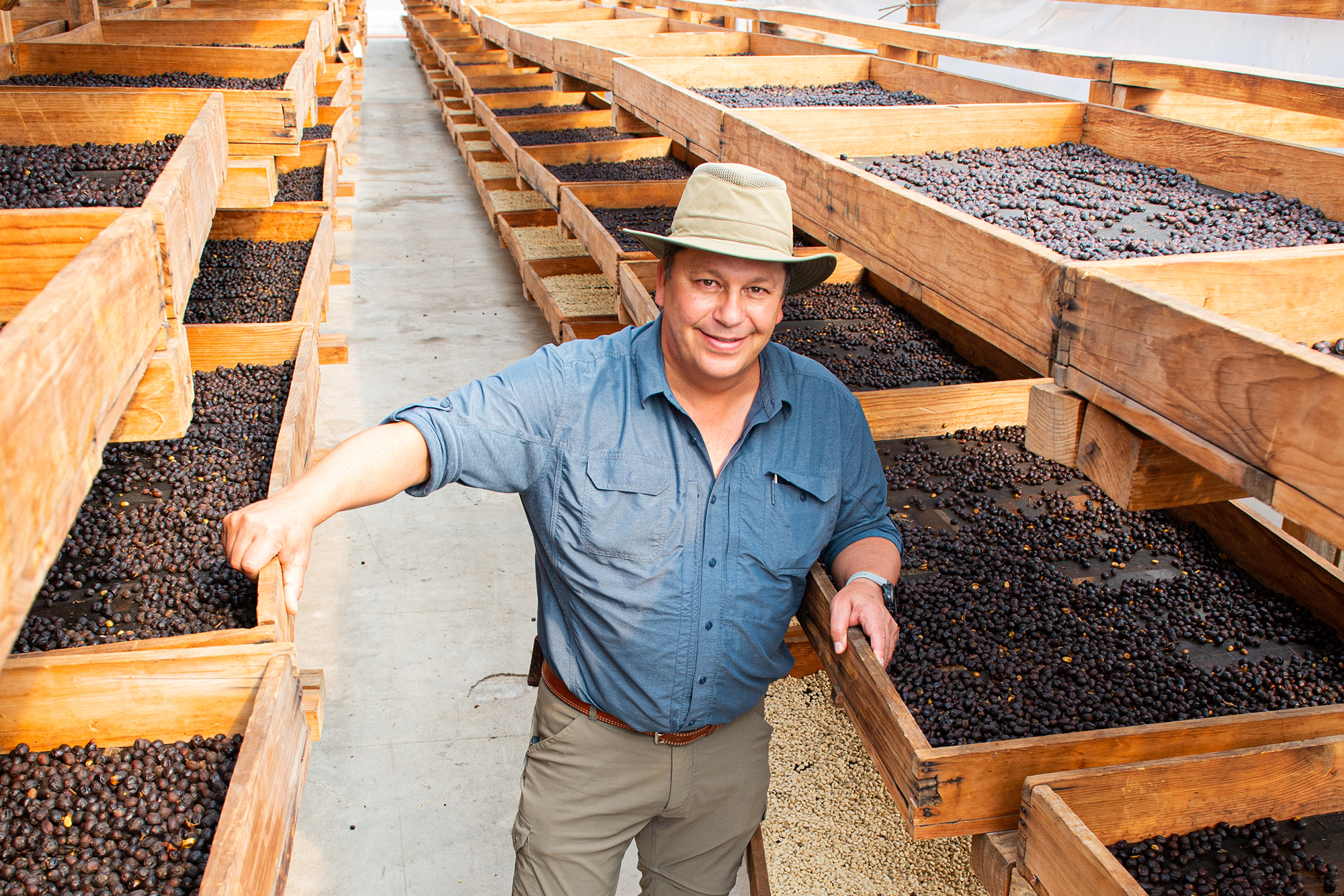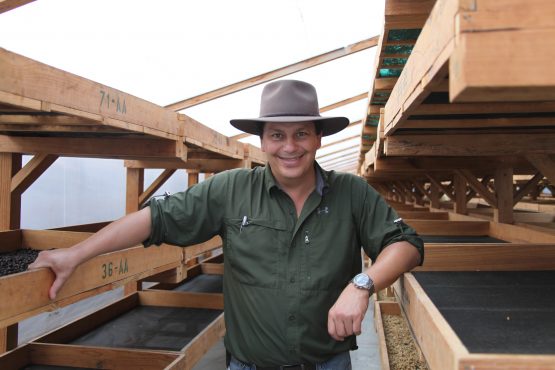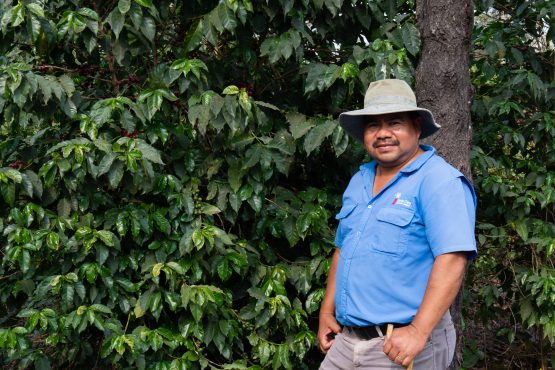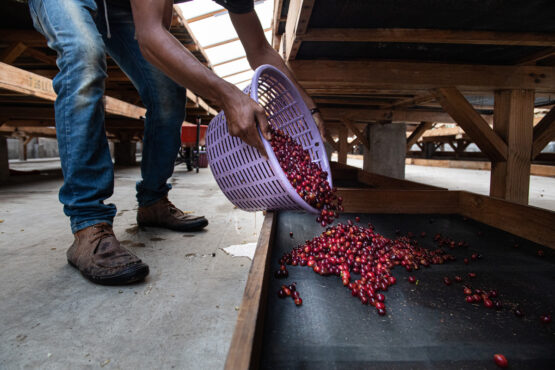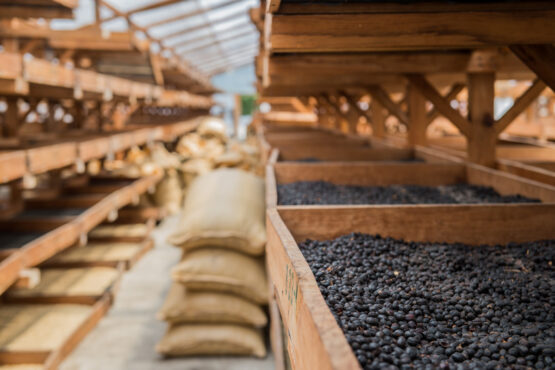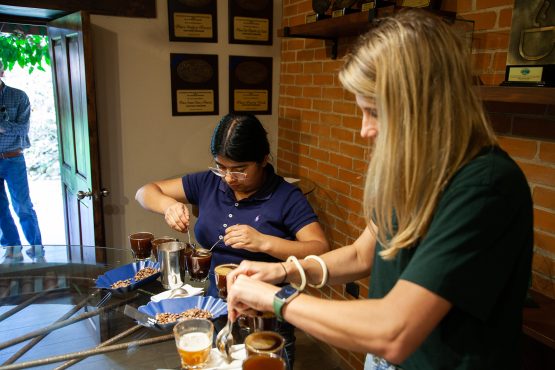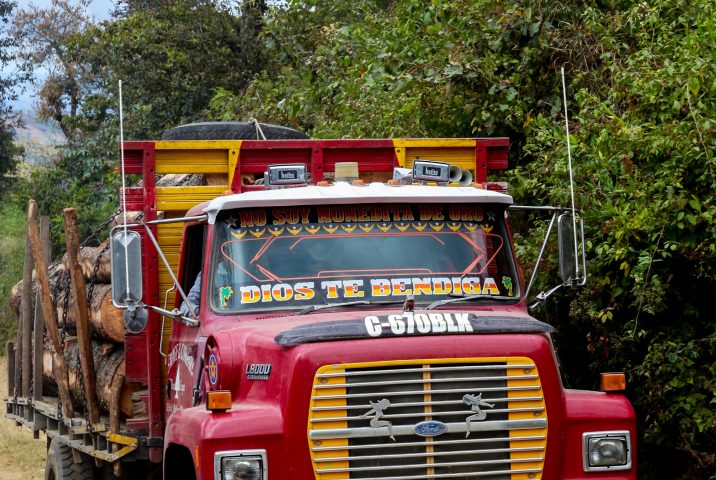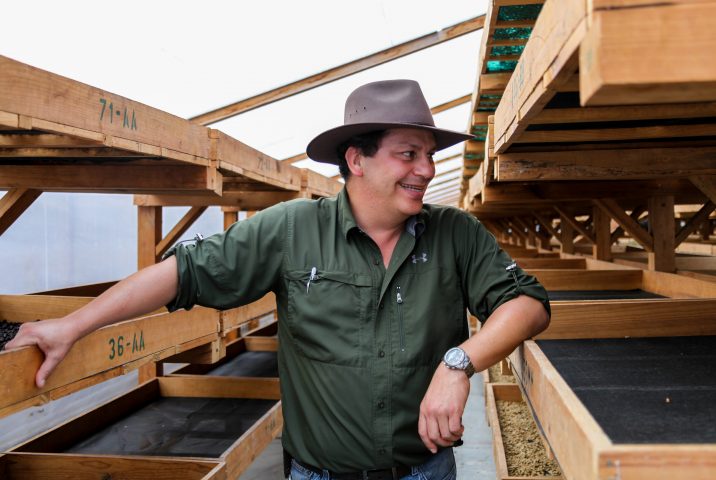Santa Clara Malawi Gesha Natural
Rich, creamy and complex, with notes of black tea, grilled peach, date and concord grape.
This Malawi Gesha-variety micro-lot is from Santa Clara Estate, in Antigua. We have been tasting and buying the Gesha variety from the Zelaya family ever since it came into production nearly a decades ago. Each year it improves, and the florals and tropical notes become more distinct. For the second year running, the family decided to process a portion of this variety as a natural, to incredible results!
The Zelaya family has been growing coffee for more than 100 years. This renowned family owns farms throughout Guatemala and grows some of only a handful of genuine ‘Antigua’ coffees (coffees grown in the Antigua valley area, bounded by three volcanoes: Agua, Acatenango and Fuego).
Finca Santa Clara is ninety hectares in size and is located on the fertile southern slopes of the Volcán de Agua, in the Antigua Valley, at 1,550–1,890 metres above sea level. The farm has been managed since 1988 by Ricardo Zelaya, the fourth generation of the Zelaya family to have produced coffee at Santa Clara.
ABOUT RICARDO ZELAYA
Ricardo is a meticulous and incredibly professional farmer who is focused on producing the very best coffee he can. He manages three coffee farms in Antigua: Santa Clara, Hacienda Carmona and Puerta Verde, and owns and manages a farm called Carrizal in the New Oriente coffee region. His farms are scrupulously well-managed—from the careful selection of varietals planted and attention given to plant nutrition and pruning, to the management and close supervision of the wet and dry mills – which are located on the estate and owned by Ricardo, giving him complete control over quality from picking through to export.
Ricardo is passionate about sustainability. Not only are 25 hectares of the estate dedicated to natural reserve, but he also grows avocados on some 4.5 hectares of land. All coffee on Ricardo’s farms is shade-grown, as this protects the plants from direct sunlight, maintains soil health, and provides an important habitat for birds and insect life. The family’s mills are also eco-friendly and feature sedimentation tanks that prevent pollution of the local river systems. All of the pulp from the mills is composted and used as an organic fertiliser for the farm. In addition, parchment from the dry mill is used for fuel to reduce the reliance on wood.
Ricardo also has a big heart – leading with passion, care, positivity and a sense of humour. He has a loyal and dedicated team, and many of his staff have worked on the farm and with the family for generations. One of his longest-standing staff members is the Farm Administrator, Marcos Rompiche, who has worked for the Zelayas for over two decades and is the third generation in his family to work the land. Production is overseen by Rubén Gonzalez, who has over twenty years experience working for the family. Including Marcos and Rubén, the farm provides work for almost seventy permanent employees year-round, all of whom help Ricardo manage the processing and production of his farms. The family hires an additional 250–350 individuals during the harvest to help pick and process the coffee.
Ricardo recognises that his people are his most valuable asset “80% of the cost of coffee is labour—you need to depend on a lot of people. I think that if your people are earning a good salary, if they have good conditions and if they’re happy, then they’ll do a better job, and with more will.”
Head here to learn more about the Zelaya family’s work in Antigua.
ABOUT THE GESHA VARIETY AT SANTA CLARA
Gesha seeds were originally collected from Ethiopian coffee forests in the 1930s. They were initially kept and studied at the Tanzania Coffee Research Institute, and subsequently at Costa Rica’s Centro Agronómico Tropical de Investigación y Enseñanza (known as CATIE). Both institutes recognised the variety’s resistance to coffee leaf rust, yet it was not propagated thoroughly due to the tree’s brittle branches. Luckily, in the 1960s, the variety was distributed to farmers in Panama by Francisco “Pachi” Serracin. Gesha trees made their way to the country’s Boquete region, where they grew at high elevations without attracting much attention from local farmers. It wasn’t until the Peterson family, in Boquete’s Hacienda La Esmeralda, noticed a number of trees that had not been affected by a recent bout of leaf rust on a newly-acquired plot of land, and decided to separate them. The rest is history: the lot produced by these trees went on to win the Best of Panama competition in 2004, as its delicate, floral aroma and distinct flavour profile pushed the boundaries of what coffee could taste like.
Ricardo first had the opportunity to cup Gesha in 2008, with Anacafe and was blown away. Determined to try this variety on his farm, Ricardo sourced some Malawi Gesha from a friend. The seeds were old, so at first it was a challenge to make them germinate in order to build a nursery – only 15 out of 500 plants survived. These 15 plants are the mothers of all the Malawi Gesha trees that are planted on the farm today – which now take up 3 hectares of land at the very highest parts of the farm 1,750 – 1,850 meters above sea level. At this elevation, the plants thrive and are often the first to ripen.
ABOUT ANTIGUA GUATEMALA
The Antigua valley is bounded by three volcanoes – Hunahpú (also called Agua in Spanish), Chi Q’aq’ (also called Fuego) and Acatenango. Of the three, Chi Q’aq’ is the only one still active. On many visits, we have been in town at times the volcano has erupted, adding some chaos to the harvest (in the short term, the ash can stick to the leaves of coffee trees nearby and prevent the trees from photosynthesising), but ultimately providing mineral-rich ash for Antigua’s soil. This volcanic matter helps the soil retain its moisture, offsetting the region’s lower rainfall.
Coffee from Antigua is perhaps Guatemala’s best-known and most celebrated and, as such, typically attracts higher prices than coffee from other regions. They tend to be heavier bodied, with notes of dark chocolate, brown sugar and red apple. In 2000, Antigua received a Denomination of Origin to recognise the region as distinct, and to prevent other coffees from being marketed as Antiguan.
The region surrounding Antigua Guatemala is the traditional land of the Kaqchikel people, who are descended from one of Guatemala’s largest Mayan kingdoms. Their ancient capital, Iximché, is located some 50km from the Antigua valley, and was considered one of the country’s most important cities before the Spanish invasion of Guatemala. The Kaqchikel are remarkable historians, and their oral and written traditions (compiled in The Annals of the Kaqchikel) have been an important resource in preserving the cultural heritage of many of Guatemala’s indigenous communities.
HOW THIS COFFEE WAS PROCESSED
Every cherry at Santa Clara is hand-picked when perfectly ripe, and then sorted by hand before being inspected by the quality control manger at the wet mill. This special micro-lot has been hand-picked by special pickers, who are employed and paid higher wages specifically for their skill at selecting only the ripest and most perfect cherries. The method of ‘special’ picking is one that the Zelayas have used to great effect in the lots that they submit to the Cup of Excellence competition. They’ve recently begun to expand their offerings of lots, such as this one, that utilize the same method of picking.
On the same day that they were picked, the fully ripe cherries were washed thoroughly in the receiving tanks, and additional water was passed over them to remove any traces of dirt. They were then left in this tank overnight. The next day the cherries were taken through the washing channels to ensure there were no floaters, and then transferred directly to the African beds inside the greenhouse where they were turned every thirty minutes initially, and then as the beans dried out this was increased to every fifteen minutes to ensure uniform drying. Drying took around twenty-one days to reach the desired moisture level.
Once dry, the coffee is rested in parchment until it is ready for export. It is then milled at Ricardo’s dry mill which is located on the farm. The management of this meticulously run mill is overseen by a talented team who carefully monitor every stage of milling to ensure high-quality expectations are met. Throughout the process, Ricardo also ensures that all organic by-products are recycled and reused.
Ricardo recently upgraded the dedicated lab on his property and has a QC team focused on analysing every single lot produced on the farm. Flor Ventura, a Santa Clara Scholarship Fund participant and coffee school graduate, heads up the QC program and is in charge of all of the roasting and cupping. Each day lot is cupped and scored prior to blending and the findings are used to inform improvements in harvesting and processing.
WHY WE LOVE IT
We have been working with Ricardo Zelaya and his family since 2008, and we feel so incredibly lucky to work with such a remarkable family and coffee.
One of our favourite moments when visiting the farm was seeing an amazing video that the staff had produced as a surprise for Ricardo and his family to show their gratitude. It was presented at their Christmas party (an annual event to which all of Santa Clara’s workers and families are invited to dance and eat lots of yummy food). You can watch here (we can’t encourage you to watch this enough—it will make you smile!).
